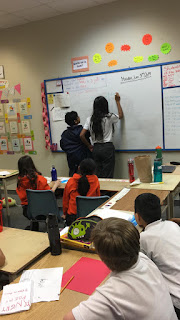We began the day awarding our principled winners in the PYP. Way to go Aishraya!!!
Then we moved onto math. Today we focused on theoretical probability.
Learning Goals: explore and apply theoretical probability
Students played a game using games to explore this concept.
You have 4 red, 3 blue, 2 yellow, 1 green. Suppose you pick 1 cube without looking. Predict the probability that you will pick each colour. Play the game 50 times.
Predictions:
Colour
|
Fraction
|
Decimal
|
Actual Results:
Colour
|
Tally
|
Frequency
|
Relative Frequency
|
How do the experimental probabilities compare with the predicted probabilities?
Colour
|
Prediction
|
Actual Results
|
How can you use the probability of picking a green cube to predict how many times a green cube will be picked in 80 games?
Does this mean that in 80 games __ green cubes will be picked? Explain.
________________________________________________________________________
We learned that They learn:
1. When the outcomes of an experiment are equally likely, the probability of any outcome is the ratio of the number of favourable outcomes to the number of possible outcomes.
This is called the theoretical probability.
2. The theoretical probability is found by analysing the possible outcomes.
3. The more times an experiment is conducted, the closer the experimental probability is to the theoretical probability.
Students then moved onto textbook questions.
Success Criteria:
-I understand that: theoretical probability is when the outcome of an experiment are equally likely, the probability of any outcome is the ratio of the number of outcomes of favourable outcomes to the number of possible outcomes
-theoretical probability is found by analyzing the possible outcomes
-the more times an experiment is conducted, the closer the experimental probability is to the theoretical probability
I can:
-find the theoretical probability based on information given
-I can use long or short division to find the theoretical probability
Next, we had French.
After first recess and lunch we read and analysed 4 more examples of how to write an interview in report form.
Then we had music class.
The rest of the day was spent writing the post Ontario Writing Assessment, writing an interview in report form.
When students were finished they had time to work on math homework.
Today we also had another summative presentation. Rhea and Shivam did a fantastic job teaching the grade 4 class all about cyberbullying!
Homework:
1. Read Daily
2. Math text questions 418-9 questions 1-5
3. Sign 3 Exhibition rubrics
4. Bring a board game to school















No comments:
Post a Comment